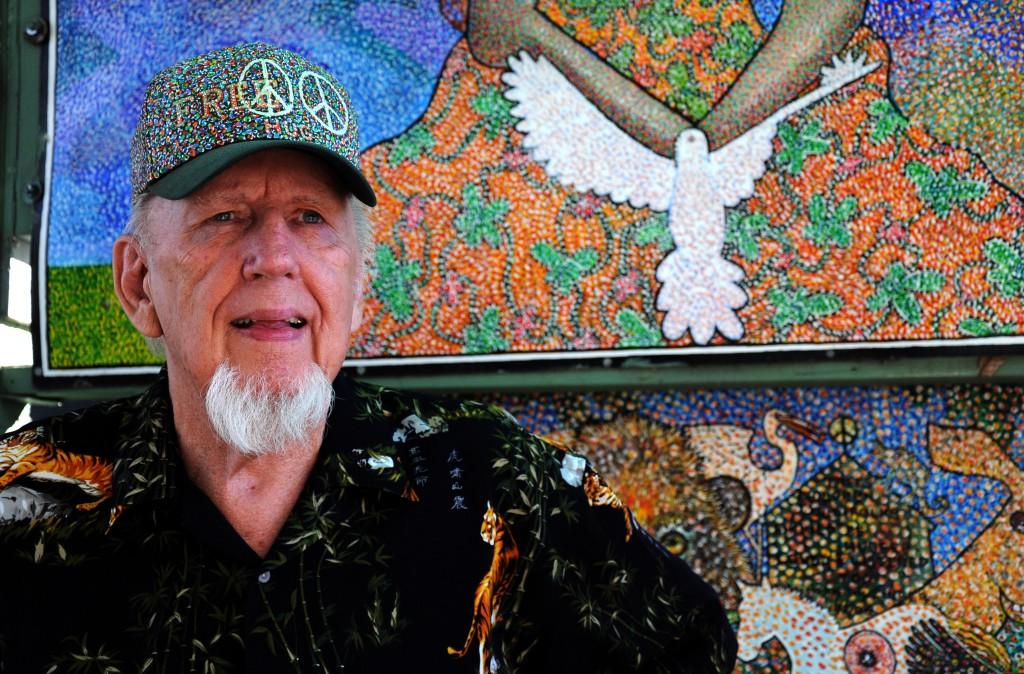
Acrylic giraffes smile down from the living room window like stained-glass saints, three koalas cling to a branch and a woman holding a cluster of balloons keeps steady on her bicycle.
Norm Dillinger, 76, has created hundreds of companions, born from perfectly placed dots of acrylic paint, to share the sunny afternoons in his home and studio at the corner of Orient Street and Highway 32.
“It’s great therapy just doing it,” Dillinger said.
The technique, known as pointillism, was developed in the late 1880s and stems from impressionism. It involves meticulously painted small dots of color that, from a distance, create a recognizable image.
“I just thought it was interesting when I started out so I just thought I’d do it,” Dillinger said. “Because not too many people do it.”
For the past 30 years he has been practicing this technique on every canvas imaginable, including his home, drums, guitars, figurines and five cars.
“When you’re following your bliss, you lose track of time,” Dillinger said.
Covered in vibrant colors, a Buddha statue invites strangers from the sidewalk to come explore the wonder of Dillinger’s home. Small animal figures sit on a sign that reads: “Art lovers welcome inside & out.”
But Dillinger said not too many people come inside, and those that do are usually young.
“Old people are usually too shy to invade somebody’s house without making a phone call,” he said.
Originally from Susanville, Calif., Dillinger attended Chico State after serving a few years in the army. He graduated in the late 60s with a marketing degree, but took as many art classes as he could.
After graduation, Dillinger spent a year at the California College of the Arts in the Bay Area.
Immersed in the civil rights movement, Dillinger said many of his teachers would cancel class to attend Black Panther Party protests.
“I got an A in the class but I don’t know why,” he said.
Somewhat frustrated, Dillinger moved back to Chico and has remained ever since.
Many wonder how long it took him to paint his entire home, the remaining two cars parked out front and the various treasures that find refuge in his garden. Dillinger doesn’t have an exact answer for them, and he thinks it’s an irrelevant question anyway.
“I like to hear how they like it, not how I do it,” Dillinger said. “Or what they don’t like about it.”
His cars make for an interesting conversation starter. Having sold three of the five intricately painted vehicles, Dillinger said owning one can definitely improve the owner’s social life.
“The last pickup I sold to a guy, that’s how he attracted his new wife,” Dillinger said. “That’s how they met.”
That makes quite the literal pickup. Although one of Dillinger’s vehicles can potentially attract a mate, he said it can be difficult to sell the cars.
“It’s kind of like selling a painting with a frame,” he said. “They gotta like the car and they gotta like the painting on the car.”
But when it works, it works well. Dillinger said the first car he sold was a Volkswagen bus with a Grateful Dead-inspired man wearing a stovepipe hat and playing the bass painted on the side.
“The guy that bought it wore a stovepipe hat and played the bass,” he said, smiling.
And although he denies that he’s used his marketing degree in the past 30 years, one could argue that driving these masterpieces around town is a marketing strategy in itself.
“By painting a car, people are going to see it,” Dillinger said. “You’re going to find out if they like it or don’t like it, so that’s the reason I did it.”
Because the cars are tedious to paint, Dillinger said the Honda Fit will be the last one. That car and another pickup truck are currently for sale.
In fact, Dillinger said he has put the paints aside and has been doing all drawings lately.
“This is probably how I’ve survived this long,” he said. “Without the art, I wouldn’t be happy. It’s a necessity of life.”
Emma Wood-Wright can be reached at artseditor@theorion.com or
@theorion_news on Twitter.





